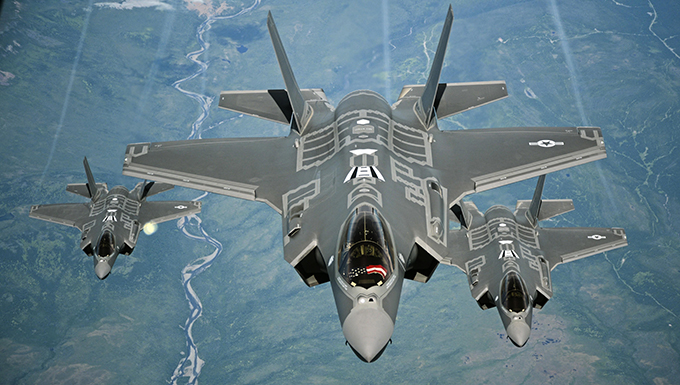
F-35As
CLARIFIED: What MG Harris Really Meant
CAPITOL HILL: The Air Force’s first operational squadron of F-35s will head to the Pacific, in addition to the European deployment recently departed Air Force Secretary Deborah Lee James discussed in December.
The news came in the form of one sentence today in the written testimony today of Maj. Gen. Jerry Harris, deputy chief of staff for strategic plans, programs, and requirements before the House Armed Services air and land subcommittee: “Our first operational squadron is scheduled for additional deployments this calendar year to include a Theater Security Package Deployment to Pacific Command.”
CLARIFICATION BEGINS: At first and second read, this seems to say that the Air Force is sending its F-35As first to the Pacific. But an Air Force spokesman said the F-35As are still heading to Europe first, per James’ comments. The key phrase here is “to include.” The Pacific deployment will ALSO happen, but after the one to Europe. At least, that’s what I was told.
So this adds a deployment to the Pacific on top of the one to Europe. This shift from a European deployment to one in the Pacific is notable as then-Secretary James told reporters five days before Christmas that the F-35As would make their first overseas deployment to Europe this summer. because it appears to signal a strategic signal by the Trump Administration to China — and perhaps one to Russia — that the U.S. will up the ante in the South and East China Seas. CLARIFICATION ENDS
The signals from the Trump administration about this have been pretty clear. Rex Tillerson, now Secretary of State, told the Senate during his nomination hearing that Chinese island building was similar to Russia’s annexation of Crimea. The United States, he said, needed to send a “clear signal that first, the island-building stops, and second, your access to those islands also not going to be allowed.”
Deploying the country’s most advanced fighter to the region would help send that signal. Of course, the Air Force planes would not be alone. The first Marine squadron of F-35Bs to deploy overseas arrived Jan. 18 at Marine Corps Air Station Iwakuni in Japan.
Lt. Gen. Chris Bogdan, the head of the Joint Strike Fighter program, told the subcommittee that he had enough money in his budget to pay for the $532 million needed to get the plane through System Development and Demonstration (SDD). However, the powerful Cost Assessment and Program Evaluation (CAPE) office estimates it will cost $1 billion. Bogdan, asked by a reporter about the discrepancy, said he didn’t know where CAPE got that estimate and said his was very accurate. CAPE estimates are usually very conservative and are often based on straight projections derived from previous weapons systems or from a program’s past performance.
Bogdan also said he’s in the “throes” of negotiations with Lockheed Martin about Low Rate Initial Production (LRIP) Lot 11 of the F-35. The 120-airplane lot will be worth upwards of $11 billion should work out to $80 million to $85 million a plane for the F-35A.
Finally, as one would expect from an officer as experienced as Bogdan, he clarified that he knew Boeing CEO Dennis Muilenburg was on the Jan. 17 phone call between him and then President-elect Trump. He described the call as “very forthright” and said President Trump “asked some very, very very good questions” about the F-35C and the F-18 Super Hornet. Everything he discussed, Bogdan said. was “publicly releasable information.” Boeing is trying hard to convince the administration that a modified F-18 could be as survivable as the F-35C and could replace a substantial portion of the F-35Cs the Navy currently plans to buy. Defense Secretary James Mattis has ordered a review of the two planes’ prices and capabilities.
Air Force picks Anduril, General Atomics for next round of CCA work
The two vendors emerged successful from an original pool of five and are expected to carry their drone designs through a prototyping phase that will build and test aircraft.


























